|
HORRID SOUNDS & HORRIBLE ACTIONS
|
The introduction
of the characters in Niels Gaup's "The Pathfinder"
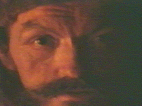
|
A narrator
begins and concludes the movie
This emphasizes
the mythic and fairy character of the film.
When a motion picture
starts and ends in a similar way it is called 'circular form'.
The similarity between the beginning and the end makes the film
feel more like an entirety.
|
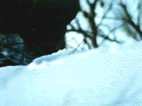
Footsteps
steg.wav
(127 K)
|
After the
initial texts the main story opens with extreme close-ups of feet
walking in snow while simultaneously a hissing murmur is heard [1]
This type of sound is
called "balloon-burner" as resembles the sound from a gas burner
heating the air in a hot-air balloon.
The sounds of footsteps has a nasty quality and reminds you of the
sound from a tarpaulin being folded. The asthmatic non-diegetic
hissing sound together with the nasty character of the footsteps
immediately inform the spectators that these are 'bad guys'. |
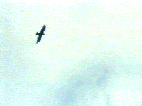 |
A croaking
raven lifts, telling in advance that something awful is going to
happen.
Ravens and crows are often used as film symbols of warning. |
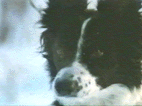 |
A dog whimpers
"nice-to-see-you", waving its tail to the approaching unknown people.
|
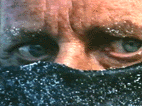 |
The viewers
get an extreme close-up of eyes.
|
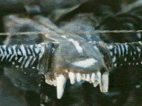 |
Then they
see a threatening cross-bow made of the skull from an animal and
see and hear the arrow leave the weapon.
|
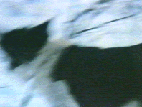
Dog Whine
gny.wav (28 K)
|
The audience
hear the whiz from the arrow, the thud when it hits and a whine
from the dog. The picture shown is foggy and filled with action.
Here the ear is leading
the eye. The audience believe they are watching the dog being shot,
but what they see is a blurred picture of a dog falling.
It's a good example
of how proficient film-makers by simple means can make us create
our own pictures with the help of sounds. The sound has to be
distinct for this cinematic device to succeed. This kind of sound-adding
is similar to that of the radio theater.
The introduction of
the 'bad' characters is completed in spite of the fact that the
spectators have seen no more then feet, eyes and weapon. Here
the film-maker has been working on the inner pictures of the audience.
From the different parts is created, by the conjured-up imagination,
a scaring whole.
|
The
introduction of the antagonists.
The introduction of a character
must be rapid and sharp, otherwise it easily feels heavy and
slow. That's above all the case with action movies. Drama movies
have a calmer way of narrating and can take more time to introducing
the different film characters.
"The Pathfinder" follows a rather
common pattern when introducing 'bad characters':
- Moving direction in picture
--> (from left to right)
)[2]
- An unpleasant sound, dark
bass note or discord is heard the first time the character
is shown. The
sound guides your perception in the direction of making the
appearance and clothes of the character feel uncomfortable..
- Unpleasant acts are being
performed. [3]
- Codes for clothes, appearance
and color.
During the period of silent films you had to introduce
the villains distinctly, using clothing codes, appearance codes
and evil actions. The crooks were wearing black hats and looking
villainous in general. They were equipped with scars and a swarthy
southern appearance.
The "classic" introduction in
the silent movie is the following scene, when…
- A person wearing a white hat
comes out from the saloon and pats the dog.
White headdress
+ Good action = Hero.
- Another person wearing a black
hat comes out and kicks the dog. Dark
headdress + Evil action = Villain.
In "The Pathfinder" they don't kick the dog, but
shoot it. To make the viewers feel sympathy for the dog, a "pity-me-whimper"
is added, for the viewer to react to instinctively with empathy
with the dog. Had the dog reacted and angrily barked, the viewers
hadn't been moved when the dog was shot.
Whining sounds reminding
you of babies' whimpering, activate man's instinct to protect.
In 10 seconds do we succeed in creating a sympathetic attitude
from the viewers towards the dog, resulting in a very strong
feeling when it dies.
 In
"The Star Wars" there is that little robot R2-D2 with a body
language like a trash can. Why do the viewers like the cute
robot? It sounds like a cross between baby babble and pup whine,
electronically transformed. These mentally absorbing sounds
make them not to care about that they are looking at a can,
by way of the sounds they experience a little helpless being..[4] In
"The Star Wars" there is that little robot R2-D2 with a body
language like a trash can. Why do the viewers like the cute
robot? It sounds like a cross between baby babble and pup whine,
electronically transformed. These mentally absorbing sounds
make them not to care about that they are looking at a can,
by way of the sounds they experience a little helpless being..[4]
Read about
the making of the sounds on my website Sound
Design of Star Wars
The silent flying raven later in
the introduction has a foreboding function. In Hitchcock's films
silence means power [5].
Squeaking sounds when the door
of the cot is opened were probably used to creating a foreboding
as well as disturbing undertone in the Soundscape. (The hinges
are made of leather)
|
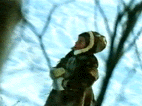
cymbal.wav (184 K)
|
If anyone
in the audience would still be uncertain of what was to come, it
ceased when the girl went out into the woods to look for the dog..
A dark bass note gives
premonition and mood, then we hear the sound from a cymbal, reversed.
The sound of asthmatic breathing is also heard. |
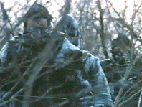 |
A wind is
heard when the girl sees the dark figures in the mountain birch
woods.
The sound of winds is
strikingly often used to emphasize the feeling of loneliness and
being abandoned. |
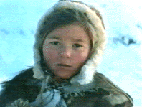
etne.wav (51 K)
|
When the audience
hear the whizzing from an arrow - repeated like an echo - they realize
that the girl is being shot
The only
thing shown is the face of the girl and then a wide open mountain
space, but the sound equipment makes the viewers see inner pictures
and these pictures are so strong that most of them will remember
having actually seen the girl being shot. [6] |

jojk.wav (260 K)
Sorry about
the bad sound quality - When I got a better copy I will webpublish
the sounds as MP3 and RealAudio
|
The introduction
of the main character is completely different from that of the evil
'tjudrerna'. A solitary skier, slowly approaching with a light timbre
in the music. Open mountain landscape in sunshine (instead of fragmentary
close-ups of trampling feet).
The 'yoik', (improvised
Laplandish chant) that is heard during the introduction has a rising
melody movement. It's a brilliant variation of the code of film
music for a hero. More absolute hero-music is to find for instance
in "Indiana Jones" and "Superman".
The picture and the
music help each other to tell that this is the hero.
The introduction of
the hero can be interpreted as an allegory over the fact that
he will mature and grow, and successfully handle the difficulties
ahead of him.
|
©
Sven E Carlsson 1998
Translated to English by Torbjoern Nilsson
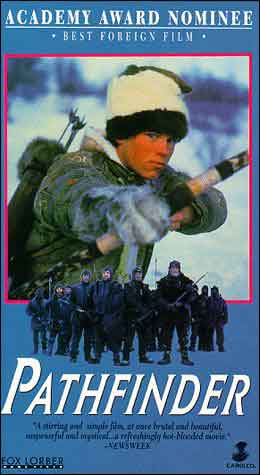
Niels
Gaup: Ofelas
aka Pathfinder (1987)
| 1.
A well-known hissing sound is Darth Vader's asthmatic respirator
in "Star Wars".
2. 'Tjudrerna' - the evil characters in "The Pathfinder" - enter
from the left.
3. In the introduction in "Star Wars" Darth Vader carried out
an evil action. He lifted up a soldier and the 'crack' was heard
when the soldier's larynx was squeezed together. Other traditional
codes of introduction were also carried out, Darth Vader is
wearing dark clothes, for instance.
Another common
thing is also that the name of characters can be associated
with their role creation. 'Darth Vader' resembles 'Dark Invader'.
4.Take
a look at my website 'Sound
Design of Star Wars' to see how the sounds were made.
5.
According to Elisabeth Weis in 'The
Silent Scream, Alfred Hitchcock's Sound Track' Farleigh
Dickensson Press (1982).
6. There
seems to be a sense transformation from auditory to visual impression.
See Chion's terms "Added Value" and "Rendering" on FilmSound.org
Diegetic
sound
Sound whose source is visible on the screen or
whose source is implied to be present by the action of the film.
For example: voices of characters or sounds made by objects
in the story
Non-diegetic
sound
Sound whose source
is neither visible on the screen nor has been implied to be
present in the action. For
example: narrator's commentary, sound effects which is added
for the dramatic effect or mood music
Soundscape
The characteristic
types of sound commonly heard in a given period or location.
For example, the late nineteenth-century American soundscape
was largely limited to unamplified, live sounds, while the soundscape
of the mid twenties included radio, electrically recorded disks,
and public address, as well as live music, theater, and an increasing
number of unmuffled motors.
|
I wrote the first
Swedish version of this article 1993 on a typerecorder. I rewrote and
webpublished the article 1998. With the help of my friend Torbjoern
Nilsson the article was translated to English 2004.
>>
This article in Swedish
Visit
FilmSound.org - Learning Space
dedicated to Film Sound Design
|